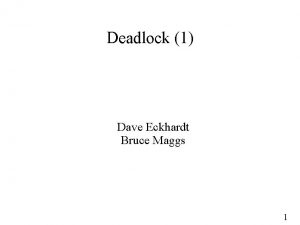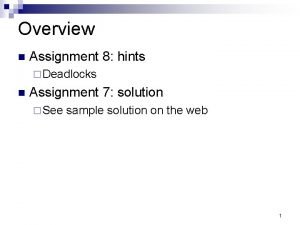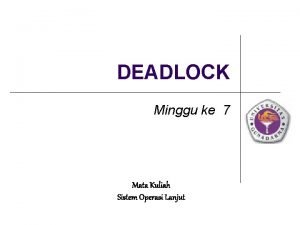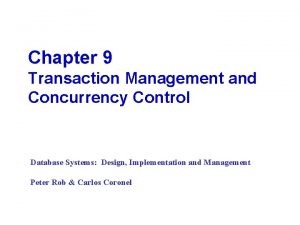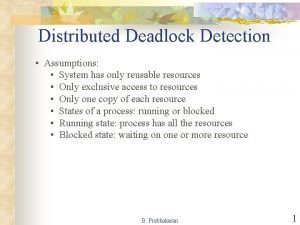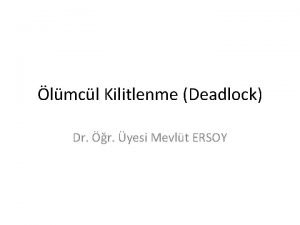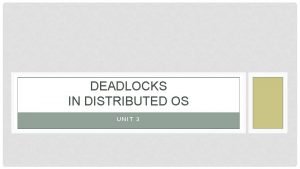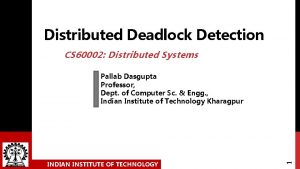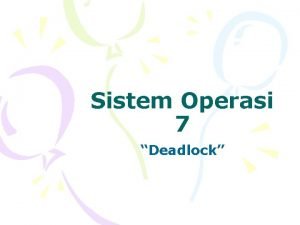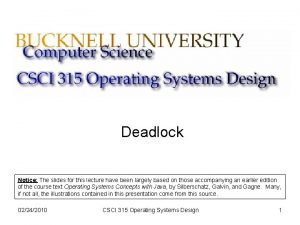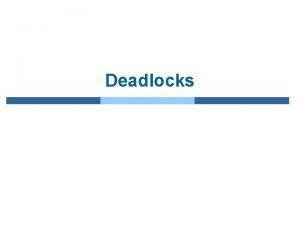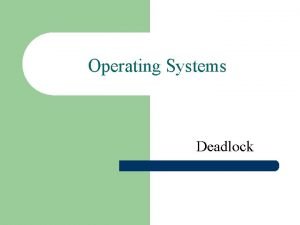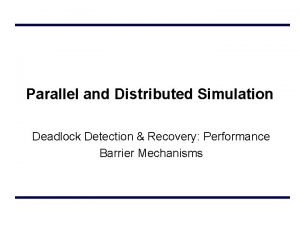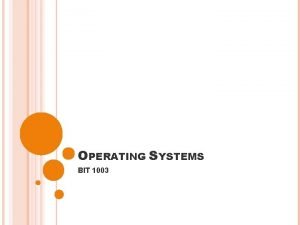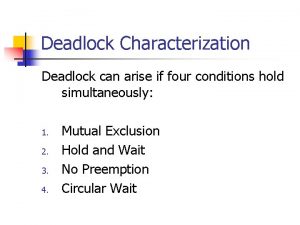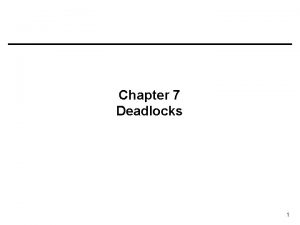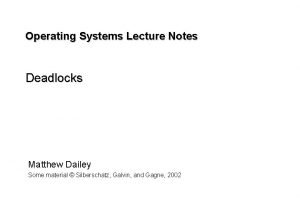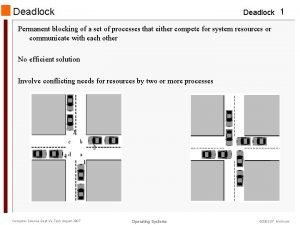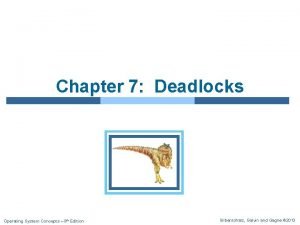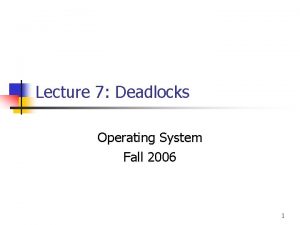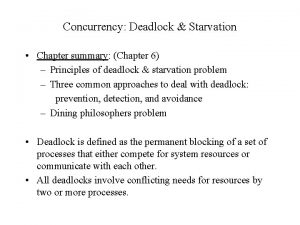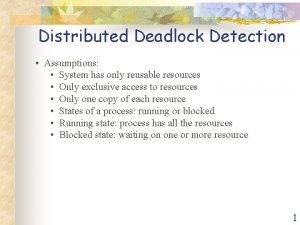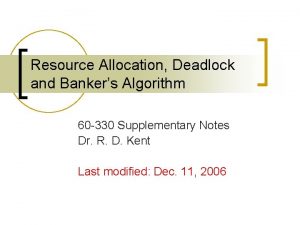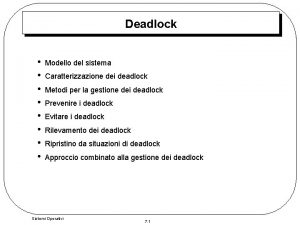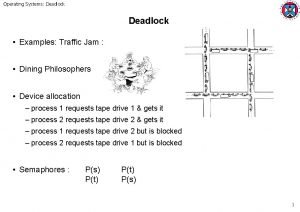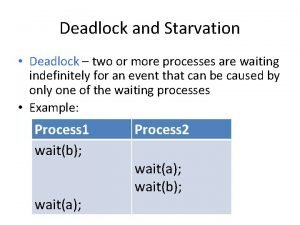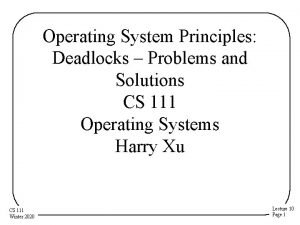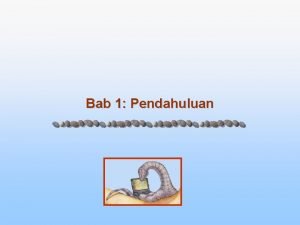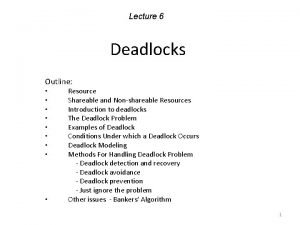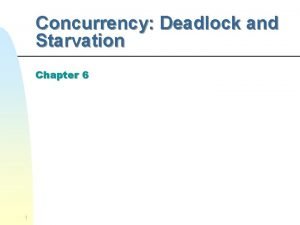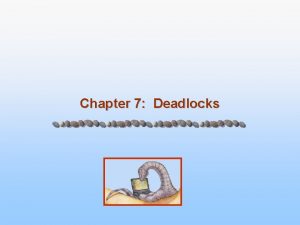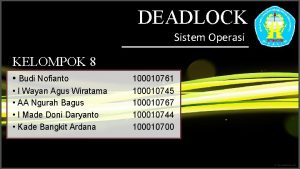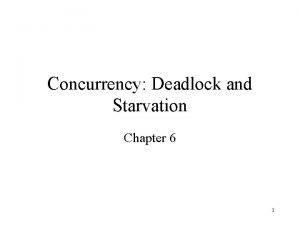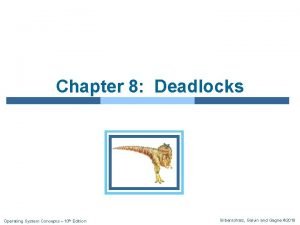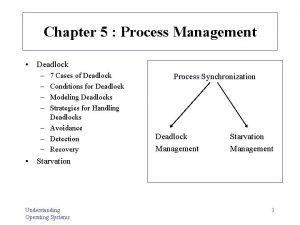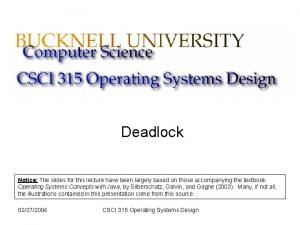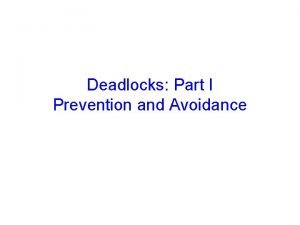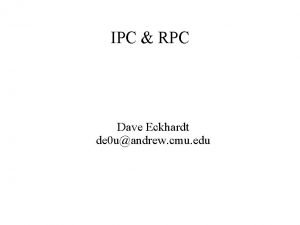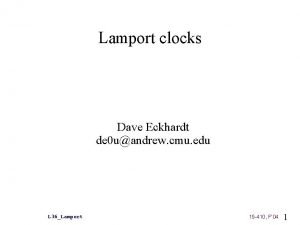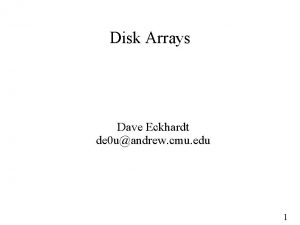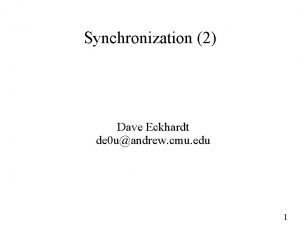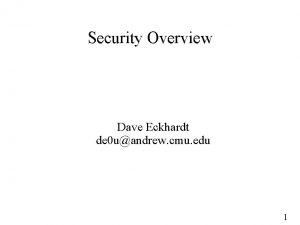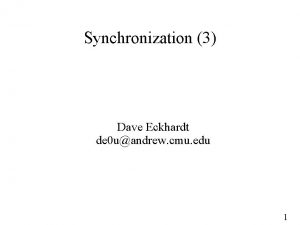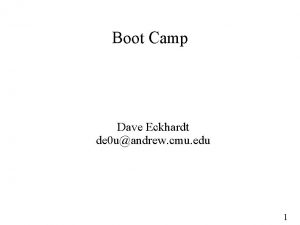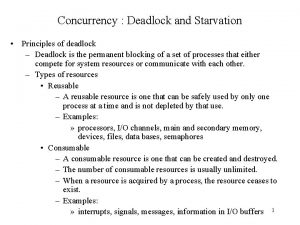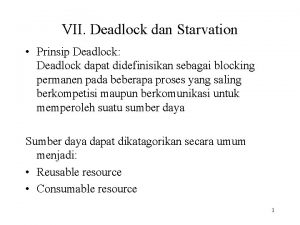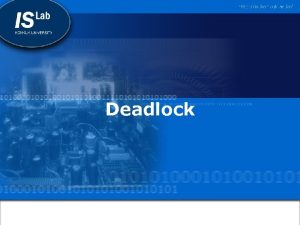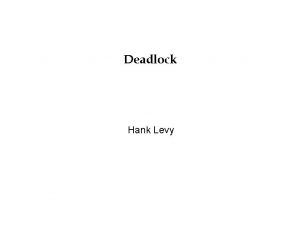Deadlock 2 Dave Eckhardt de 0 uandrew cmu


































![Banker's Algorithm int cash; int limit[N]; /* credit limit */ int out[N] /* borrowed Banker's Algorithm int cash; int limit[N]; /* credit limit */ int out[N] /* borrowed](https://slidetodoc.com/presentation_image/04556eb3fd3aa9645c1f2118e896f0b1/image-35.jpg)
![Banker's Algorithm boolean is_safe(void) { future = cash; done[0. . N] = false; while Banker's Algorithm boolean is_safe(void) { future = cash; done[0. . N] = false; while](https://slidetodoc.com/presentation_image/04556eb3fd3aa9645c1f2118e896f0b1/image-36.jpg)














- Slides: 50

Deadlock (2) Dave Eckhardt de 0 u@andrew. cmu. edu 1

Synchronization ● Poll: “Memory Hierarchy” lecture? – The pyramid, line size, associativity, eviction, . . . ? 1

P 2 issues ● Stack overflow ● Thread vs. process ● The scheduler rule ● brk() semantics ● must read the bboards 1

Outline ● Review – ● Prevention/Avoidance/Detection Today – Avoidance – Detection/Recovery 1

Deadlock - What to do? ● Prevention – ● ● Pass a law against one of four ingredients Avoidance – Processes pre-declare usage patterns – Request manager avoids “unsafe states” Detection/Recovery – Clean up only when trouble really happens 1

Deadlock Avoidance – Motivation ● Deadlock prevention passes laws – Unenforceable: shared CD-writers – Annoying: lock order can induce starvation ● ● Lots of starvation opportunities Do we really need such strict laws? – Couldn't we be more situational? 1

Deadlock Avoidance Assumptions ● Processes pre-declare usage – Request R 1, Request R 2, Release R 1, Request R 3, . . . – Easier: declare maximal resource usage ● ● I will never need more than 7 tape drives and 1 printer Processes proceed to completion – Don't hold onto resources forever ● – Obvious Complete in reasonable time ● Worst-case-ok to stall P 2 until P 1 finishes 1

Safe Execution Sequence ● P 1, P 2, P 3, . . . Pn safe sequence if – Every process Pi can be satisfied using ● ● currently-free resources plus resources held by P 1, P 2, . . . Pi-1 Bound Pi's waiting – P 1 will run to completion, release resources – P 2 can complete with now-free + P 1's + P 2's – P 3 can complete with now-free + P 1's + P 2's + P 3's Pi won't wait forever, no wait cycle, no deadlock 1

Safe State ● System in a safe state if – ● ● there exists one safe sequence Worst-case behavior – Everybody asks for everything at once – Follow the safe sequence Serial execution is worst-case, not typical – Usually execute in parallel 1

Request Manager - Naïve ● Grant request if – ● Enough resources are free now Otherwise, wait – While holding resources ● ● Which are non-preemptible Easily leads to deadlock 1

Request Manager – Avoidance ● Grant request if – Enough resources are free now – Enough resources would still be free ● ● For somebody to complete And then somebody else And then you Otherwise, wait – While holding resources ● Which other processes can complete without 1

Example (from text) 1

P 1: 2 4 1

P 1: complete 1

P 0: 5 10 1

P 0: complete 1

Example (from text) 1

P 2: 2 3? 1

P 1: 2 4? 1

P 1: complete? 1

Avoidance - Key Ideas ● Safe state – Some safe sequence exists – Prove it by finding one ● Unsafe state: No safe sequence exists ● Unsafe may not be fatal ● – Processes might exit early – Processes might not use max resources today Rejecting all unsafe states reduces efficiency 1

Avoidance - Unique Resources ● Unique resources instead of multi-instance? – ● Graph algorithm Three edge types – Claim (future request) – Request – Assign 1

“Claim” (Future-Request) Edges 1

Claim Request 1

Request Assignment 1

Safe: No Cycle 1

Which Requests Are Safe? ● Pretend to satisfy request ● Look for cycles in resultant graph 1

A Dangerous Request 1

See Any Cycles? 1

Are “Pretend” Cycles Fatal? ● ● Must we worry about all cycles? – Nobody is waiting on a “pretend” cycle – We don't have a deadlock “Is it safe? ” 1

Are “Pretend” Cycles Fatal? ● No process can, without waiting – ● So no process can acquire, complete, release – ● (for sure, without maybe waiting) Any new sleep could form a cycle – ● Acquire maximum-declared resource set “No, it's not safe, it's very dangerous, be careful. ” What to do? – Don't grant the request (put the process to sleep now) 1

Avoidance - Multi-instance Resources ● ● Example – N interchangeable tape drives – Could represent by N tape-drive nodes – Needless computational expense Business credit-line model – Bank assigns maximum loan amount (“credit limit”) – Business pays interest on current borrowing amount 1

Avoiding “bank failure” ● Bank is “ok” when there is a safe sequence ● One company can ● – Borrow up to its credit limit – Do well – IPO – Pay back its full loan amount And then another company, etc. 1

No safe sequence? ● ● Company tries to borrow up to limit – Bank has no cash – Company C 1 must wait for money C 2 has – Maybe C 2 must wait for money C 1 has In real life – C 1 cannot make payroll – C 1 goes bankrupt – Loan never paid back in full ● Can model as “infinite sleep” 1
![Bankers Algorithm int cash int limitN credit limit int outN borrowed Banker's Algorithm int cash; int limit[N]; /* credit limit */ int out[N] /* borrowed](https://slidetodoc.com/presentation_image/04556eb3fd3aa9645c1f2118e896f0b1/image-35.jpg)
Banker's Algorithm int cash; int limit[N]; /* credit limit */ int out[N] /* borrowed */; boolean done[N]; /* global temp! */ int future; /* global temp! */ int progressor (int cash) { for (i = 0; i < N; ++i) if (!done[i]) if (cash >= limit[i] - out[i]) return (i); return(-1); } 1
![Bankers Algorithm boolean issafevoid future cash done0 N false while Banker's Algorithm boolean is_safe(void) { future = cash; done[0. . N] = false; while](https://slidetodoc.com/presentation_image/04556eb3fd3aa9645c1f2118e896f0b1/image-36.jpg)
Banker's Algorithm boolean is_safe(void) { future = cash; done[0. . N] = false; while (p = progressor(future)) future += borrowed[p]; done[p] = true; return (done[0. . N] == true) } 1

Banker's Algorithm ● Can we loan more money to a company? – Pretend we did ● – Is it safe? ● ● ● update cash and out[i] Yes: lend more money No: un-do to pre-pretending state, sleep Multi-resource Version – Generalizes easily to N independent resource types – See text 1

Avoidance - Summary ● ● Good news - No deadlock – No static “laws” about resource requests – Allocations flexible according to system state Bad news – Processes must pre-declare maximum usage – Avoidance is conservative ● ● ● Many “unsafe” states are almost safe System throughput reduced – extra sleeping 3 processes, can allocate only 2 tape drives!? !? 1

Deadlock - What to do? ● Prevention – ● ● Pass a law against one of four ingredients Avoidance – Processes pre-declare usage patterns – Request manager avoids “unsafe states” Detection/Recovery – Clean up only when trouble really happens 1

Detection & Recovery - Approach ● Don't be paranoid – Don't refuse requests that might lead to trouble ● ● ● (someday) Most things work out ok in the end Even paranoids have enemies – Sometimes a deadlock will happen – Need a plan for noticing – Need a policy for reacting – Somebody must be told “try again later” 1

Detection - Key Ideas ● “Occasionally” scan for wait cycles ● Expensive – Must lock out all request/allocate/deallocate activity – Global mutex is the “global variable” of concurrency – Detecting cycles is an N-squared kind of thing 1

Scanning Policy ● ● Throughput balance – Too often - system becomes (very) slow – Before every sleep? Only in small systems – Too rarely - system becomes (extremely) slow Policy candidates – Scan every <interval> – Scan when CPU is “too idle” 1

Detection - Algorithms ● Detection: Unique Resources – Search for cycles in resource graph ● ● Detection: Multi-instance Resources – Slight variation on Banker's Algorithm ● ● (see above) (see text) Now what? – Abort – Preempt 1

Recovery - Abort ● Evict processes from the system ● All processes in the cycle? ● – Simple & blame-free policy – Lots of re-execution work later Just one process in the cycle? – Often immediately creates a smaller cycle – re-scan? – Which one? ● ● ● Priority? Work remaining? Clean-up work? 1

Recovery – Can we do better? ● Motivation – Re-running processes is expensive – Long-running tasks may never complete – Starvation 1

Recovery - Resource Preemption ● Tell some process(es) – ● Policy question: which one? – ● lock(R 347) “ “Deadlock!” Lowest-numbered? starvation! What does “Deadlock!” mean? – Can't just retry the request!! – Must release other resources, try later – Forced release may require “rollback” (yuck) 1

Summary - Deadlock ● Deadlock is. . . – Set of processes – Each one waiting for something held by another ● Four “ingredients” ● Three approaches – (aside from “Hmmm. . . <reboot>”) 1

Deadlock - Approaches ● Prevention - Pass a law against one of: – Mutual exclusion (right!) – Hold & wait (maybe. . . ) – No preemption (maybe? ) – Circular wait (sometimes) 1

Deadlock - Approaches ● Avoidance - “Stay out of danger” – ● ● Not all “danger” turns into trouble Detection & Recovery – Frequency: delicate balance – Preemption is hard Rebooting – Was it really hung? 1

Summary - Starvation ● Starvation is a ubiquitous danger ● Prevention is one extreme – Need something “illegal”? ● ● “Illegal” = Eternal starvation! Detection & Recovery – Less structural starvation – Silll must make good choices 1
 Dave eckhardt
Dave eckhardt Dr. eckhardt biermann
Dr. eckhardt biermann What are two pitfalls (problems) of lock-based protocols
What are two pitfalls (problems) of lock-based protocols Coffman conditions
Coffman conditions Deadlock sistem operasi
Deadlock sistem operasi Safe and unsafe state in deadlock
Safe and unsafe state in deadlock Cmh algorithm for deadlock detection
Cmh algorithm for deadlock detection Starvation deadlock
Starvation deadlock Deadlock
Deadlock Deadlock in distributed operating system
Deadlock in distributed operating system Control organization for distributed deadlock detection
Control organization for distributed deadlock detection Resource allocation graph deadlock
Resource allocation graph deadlock Resource allocation graph with a deadlock
Resource allocation graph with a deadlock Deadlock notice
Deadlock notice Strategi menghadapi deadlock
Strategi menghadapi deadlock Deadlock
Deadlock Deadlock
Deadlock Deadlock detection and recovery
Deadlock detection and recovery Deadlock
Deadlock Deadlock adalah
Deadlock adalah Bankers safety algorithm
Bankers safety algorithm Deadlock
Deadlock Deadlocks
Deadlocks Deadlock
Deadlock Methods of handling deadlock in os
Methods of handling deadlock in os Principles of deadlock
Principles of deadlock Methods of handling deadlock in os
Methods of handling deadlock in os Integrated deadlock strategy
Integrated deadlock strategy System model in deadlock in os
System model in deadlock in os Deadlock
Deadlock Path pushing algorithm
Path pushing algorithm Deadlock
Deadlock Java deadlock detection
Java deadlock detection Deadlock sql
Deadlock sql Deadlock
Deadlock Deadlock
Deadlock Deadlock
Deadlock Deadlock and starvation
Deadlock and starvation Deadlock problems and solutions in operating system
Deadlock problems and solutions in operating system Deadlock
Deadlock Deadlock sistem operasi
Deadlock sistem operasi Shareable and non-sharable resources examples
Shareable and non-sharable resources examples Deadlock vs starvation
Deadlock vs starvation Methods of handling deadlock in os
Methods of handling deadlock in os Kesimpulan deadlock
Kesimpulan deadlock Deadlock chapter 37
Deadlock chapter 37 Redshift deadlock detected
Redshift deadlock detected Circular wait in operating system
Circular wait in operating system Seven cases of deadlock in operating system
Seven cases of deadlock in operating system Deadlock notice
Deadlock notice Starvation vs deadlock
Starvation vs deadlock
